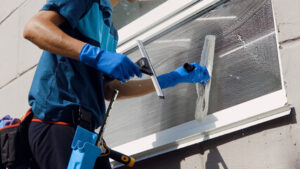Martini Exterior Cleaning involves cleaning a property’s walls, windows, doors, roofs, and gutters. This type of professional cleaning helps to remove dirt, mildew, and moss from exterior surfaces, thereby making them look visually appealing.

Whether your goal is to sell or simply enjoy your home, enhancing its appearance is always a wise investment. Often, the exterior of your property is what first attracts or turns off potential buyers, so curb appeal plays a major role in influencing their decision to view or consider your home further. In fact, research suggests that most buyers form their initial impression of a property within the first eight seconds of seeing it. A well-manicured garden, vibrant flowers and shrubbery, and an updated front door are among the most effective ways to boost a property’s visual appeal and enhance its overall look.
Curb appeal encompasses all the aspects of a property that can be seen from the street or sidewalk, including the landscape and condition of the home, siding and trim color, and the driveway and walkways. Increasing your curb appeal can be as simple as planting a few colorful blooms or adding a few well-placed trees, but it can also involve more extensive landscaping projects and improvements like a new paint job. You may even wish to add a fresh coat of paint to your front door, shutters, or mailbox, choosing colors that are in keeping with the rest of your home’s exterior design.
Aside from improving your property’s aesthetics, curb appeal can increase your home’s resale value. In fact, real estate professionals agree that a home with a great deal of curb appeal will often sell at higher prices than similar homes with less desirable landscaping or a shabby paint job.
Moreover, aside from its direct impact on your property’s resale value, maintaining your home’s exterior curb appeal ensures that it is structurally sound. Over time, excessive debris and dirt can take a toll on roofs, sidings, and other exterior residential structures, causing them to deteriorate or become susceptible to damage and leaks. Performing regular exterior cleaning helps to prevent such damage and keep your family safe and comfortable for years to come.
Structural Integrity
Whether it’s a home or a commercial building, structural integrity is important. Without it, the structure could fail catastrophically. This can result in injury, property damage, or even death. To ensure that a structure is safe and that it can withstand environmental conditions, it should be tested by a qualified engineer. Depending on the results, the engineer may recommend changes to improve the integrity of the structure.
Structural inspections are often overlooked but they are essential to ensuring the safety of the people using and inhabiting it. A good engineer can help develop systems to make sure that structural inspections are carried out regularly.
Many structural failures occur because the designer did not take into account the condition or requirements of a building or structure. They might have been influenced by cost constraints, time pressures, or the lack of knowledge of the materials they were working with. Taking shortcuts during the construction process can also cause problems with the integrity of structures. For example, if substandard materials are used, the load-bearing strength of the structure can be significantly reduced.
The integrity of a building or structure must be maintained for its entire lifespan. Over time, all types of material deteriorate, which can lead to cracks, deformation, and ultimately catastrophic failure. It is the job of engineers to ensure that a structure will be able to perform its intended function throughout its lifetime.
In addition to maintaining the integrity of a structure, engineers must also look at its ability to withstand extreme conditions such as earthquakes or storms. They must also understand how to identify deterioration mechanisms, which can be difficult for those not familiar with the material they are testing.
If you are interested in learning more about the structural integrity of a structure, TWI Training and Examination offers a number of global courses. These include the Structural Inspection course which covers how to inspect and assess a variety of structural assets. The Corrosion Detection and Monitoring – Conventional Ultrasonic Inspection based on API RP 571 course is another which looks at how corrosion affects the structural integrity of industrial plants.
Energy Efficiency
The dirt and grime that collects on the exterior of a home can actually affect energy efficiency. Dirty surfaces absorb the sun’s rays and heat, which can cause the homeowner to spend more money on cooling the house during warmer months. By hiring an exterior cleaning service, the stains and build-up can be removed to allow sunlight to reach all areas of the home, keeping energy costs lower.
Adding exterior cleaning services to your business’s repertoire can help you expand your client base and increase your revenue. Offering this service will also help to maintain the value of your clients’ homes, which is an important factor in retaining customers and building referrals.
Most professionals recommend washing the exterior of a home twice per year to avoid moisture damage. Regularly washing the exterior of a house will also prevent costly repairs and renovations that can result from moisture accumulation such as roof leaks or paint fading due to sun exposure. In addition, it will help to keep energy bills low by removing the mold, dirt, dust, moss, pollen, and other materials that are absorbing the sun’s rays and causing the AC to work harder.
In addition, dirty properties are often a haven for pest infestations that can overtake the property incredibly quickly. The bugs, ants, and termites that thrive in filthy conditions can cause a lot of damage to the structure of a home as well as lead to health issues for homeowners. Regularly washing a home’s exterior will eliminate the growth of these pests and keep them away from your client’s residences.
A professional exterior cleaner will use the right tools and cleaning products to clean surfaces like windows, gutters, roofs, walls, and driveways without damaging them. Generally, this will be done with a high-powered pressure washer that sprays hot water at a high velocity to remove dirt, stains, and other unwanted material from the exterior of the home. In addition to a power washer, most cleaning professionals will also use a special type of soap that is safe for the surface being cleaned and works well to sanitize and break down organic material like mold, algae, and mildew.
Safety
Besides being an eyesore, dirt buildup on the exterior of your property can also be dangerous. Dirt and grime accumulates on the building and can have a corrosive effect on its structure, especially if it’s allowed to remain in place for too long. Having your exterior regularly washed by professional cleaners ensures that this debris is removed before it’s able to cause damage.
The weather, pollution, moss, mildew and lichen are just some of the things that can affect the condition of your exterior. If you live in a wooded area with many trees, these can also drop leaves, pollen, and berries which can accelerate the rate of surface degradation. Cleaning services can use best-in-class equipment and techniques to scrub, wash, cleanse and sanitize the surface of your building, keeping it safe, clean and hygienic.
Professional cleaners are also adept at removing biological growths that are hazardous to health, such as mold, moss and algae. Using soft washing methods which reduce the impact of high-pressure water, they can safely and effectively remove these substances without damaging surfaces. Often times, these growths require more than just a power wash and may need to be treated with chemicals.
While some homeowners can undertake this project themselves, it’s often safer and more effective to leave this work to the professionals. This is especially true if the walls are a bit taller and you don’t have access to a ladder.
Hiring professional exterior cleaning services is a cost-effective preventative measure against significant repairs and premature replacements. By scheduling routine cleanings, you can protect the integrity of your home and keep it looking great for years to come. To get started, contact the team at Homescapes Powerwashing LLC today! We have the equipment and expertise to tackle any cleaning job – large or small. We are also committed to environmentally conscious practices and can provide cleaning options that are safe for your family, pets, and plants. We look forward to hearing from you!

